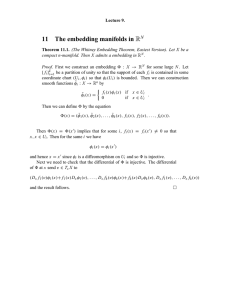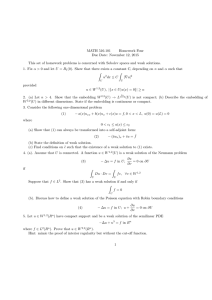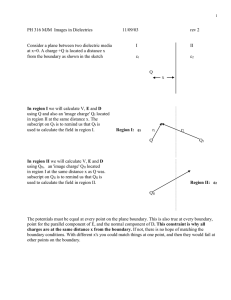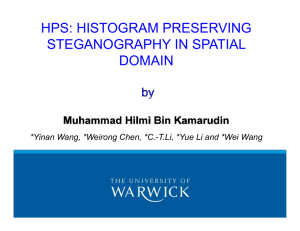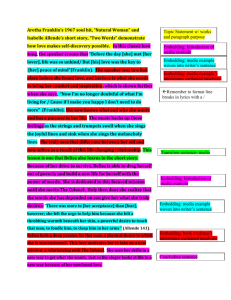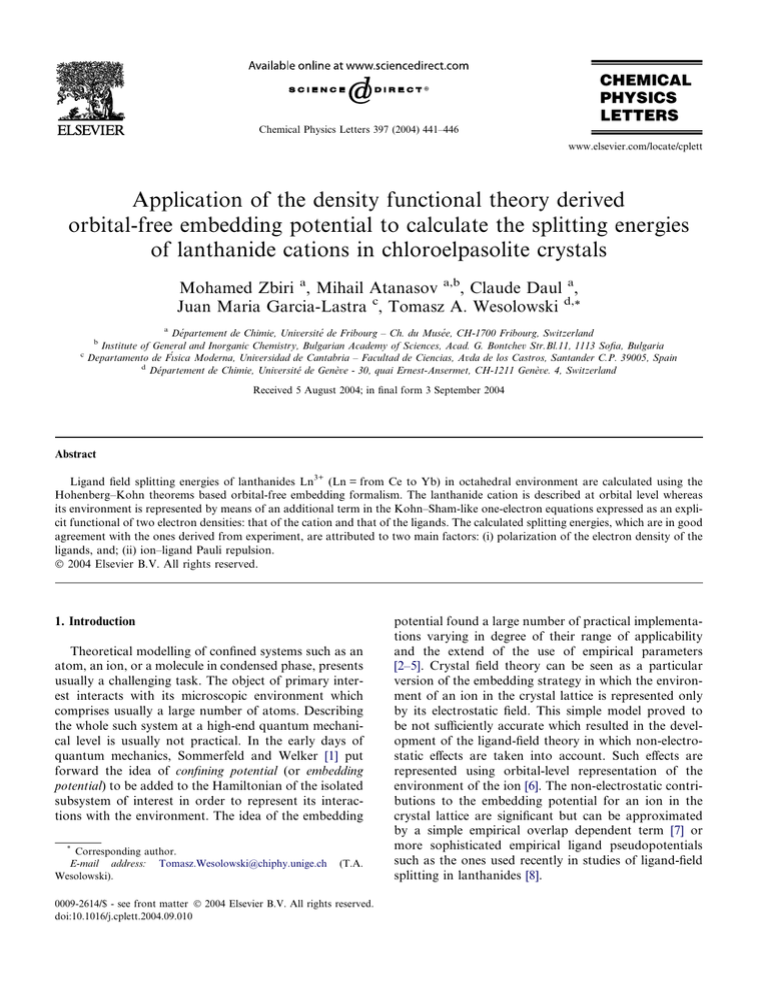
Chemical Physics Letters 397 (2004) 441–446
www.elsevier.com/locate/cplett
Application of the density functional theory derived
orbital-free embedding potential to calculate the splitting energies
of lanthanide cations in chloroelpasolite crystals
Mohamed Zbiri a, Mihail Atanasov a,b, Claude Daul a,
Juan Maria Garcia-Lastra c, Tomasz A. Wesolowski d,*
a
Département de Chimie, Université de Fribourg – Ch. du Musée, CH-1700 Fribourg, Switzerland
Institute of General and Inorganic Chemistry, Bulgarian Academy of Sciences, Acad. G. Bontchev Str.Bl.11, 1113 Sofia, Bulgaria
Departamento de Fı´sica Moderna, Universidad de Cantabria – Facultad de Ciencias, Avda de los Castros, Santander C.P. 39005, Spain
d
Département de Chimie, Université de Genève - 30, quai Ernest-Ansermet, CH-1211 Genève. 4, Switzerland
b
c
Received 5 August 2004; in final form 3 September 2004
Abstract
Ligand field splitting energies of lanthanides Ln3+ (Ln = from Ce to Yb) in octahedral environment are calculated using the
Hohenberg–Kohn theorems based orbital-free embedding formalism. The lanthanide cation is described at orbital level whereas
its environment is represented by means of an additional term in the Kohn–Sham-like one-electron equations expressed as an explicit functional of two electron densities: that of the cation and that of the ligands. The calculated splitting energies, which are in good
agreement with the ones derived from experiment, are attributed to two main factors: (i) polarization of the electron density of the
ligands, and; (ii) ion–ligand Pauli repulsion.
Ó 2004 Elsevier B.V. All rights reserved.
1. Introduction
Theoretical modelling of confined systems such as an
atom, an ion, or a molecule in condensed phase, presents
usually a challenging task. The object of primary interest interacts with its microscopic environment which
comprises usually a large number of atoms. Describing
the whole such system at a high-end quantum mechanical level is usually not practical. In the early days of
quantum mechanics, Sommerfeld and Welker [1] put
forward the idea of confining potential (or embedding
potential) to be added to the Hamiltonian of the isolated
subsystem of interest in order to represent its interactions with the environment. The idea of the embedding
*
Corresponding author.
E-mail address: Tomasz.Wesolowski@chiphy.unige.ch
Wesolowski).
(T.A.
0009-2614/$ - see front matter Ó 2004 Elsevier B.V. All rights reserved.
doi:10.1016/j.cplett.2004.09.010
potential found a large number of practical implementations varying in degree of their range of applicability
and the extend of the use of empirical parameters
[2–5]. Crystal field theory can be seen as a particular
version of the embedding strategy in which the environment of an ion in the crystal lattice is represented only
by its electrostatic field. This simple model proved to
be not sufficiently accurate which resulted in the development of the ligand-field theory in which non-electrostatic effects are taken into account. Such effects are
represented using orbital-level representation of the
environment of the ion [6]. The non-electrostatic contributions to the embedding potential for an ion in the
crystal lattice are significant but can be approximated
by a simple empirical overlap dependent term [7] or
more sophisticated empirical ligand pseudopotentials
such as the ones used recently in studies of ligand-field
splitting in lanthanides [8].
442
M. Zbiri et al. / Chemical Physics Letters 397 (2004) 441–446
Hohenberg–Kohn theorems [9] provide a general theoretical framework to construct the first-principles
based embedding potential [10]. The electron density
of a subsystem (qI) embedded in a given microscopic
environment (qII) can be derived form a constrained
minimization of the total energy bi-functional E[qI, qII]
keeping qII frozen. In this work, a new type of application of this formalism is reported-the studies of the electronic structure of embedded lanthanide ions. It is its
first application to f-elements. Lanthanide chloroelpasolites, Cs2NaLnCl6 (Ln = lanthanide) are very suitable
objects for the study of the applicability of the orbitalfree embedding formalism to f-elements owing to the
rich collection of data concerning their properties
[11–13].
The principal objective of this work is the exploration
of a new area of applicability (f-elements) of the developed approximations to the orbital-free embedding
potential. The second objective of this work is the
assessment of relative importance of various contributions to the splitting energy, such as electrostatic interactions with not-polarized ligands, electric polarization of
the ligands, and the non-electrostatic overlap-dependent
effects, and orbital interactions.
2. Computational details
theory [15] for two subsystems which might be described
using different levels of approximation. Applying the
orbital-free embedding formalism to derive f-level splitting energies can be also seen as a non-empirical realization of the original ideas of Schäffer and Jørgensen [17]
developed further by Urland [18].
Gradient-dependent
functionals
approximating
T nad
s ½qI ; qII and E xc ½q make it possible to study only
such systems for which the overlap between qI and qII
is small [19]. See [16] for review of recent applications.
In this work, we use the approximate functionals which
were chosen based on dedicated studies concerning
T nad
s ½qI ; qII [19] and the whole bi-functional E[qI, qII]
[20].
Fig. 1 represents the investigated system comprising
an octahedral arrangement of the lanthanide cation
and its ligands (Oh symmetry). The lanthanide–ligand
distances derived from ab initio (CASSCF or CASPT2)
cluster calculations [21] were used.
The principal results were obtained using qII minimizing the total-energy bi-functional E[qI, qII] in Eq. (2) in
the Ôfreeze-and-thawÕ cycle of iterations [22]. This density
is labeled as relaxed qII throughout this work. Relativistic scalar ZORA [23], all electron calculations were performed using the ZORA triple-f STO set plus one
polarization function [24]. The van Leeuwen–Baerends
(LB94) exchange-correlation potential [25] was used to
The minimization of the total-energy bi-functional
E[qI, qII], where qI and qII correspond to the electron
density of the cation and the ligands, respectively, is performed by means of the Kohn–Sham-like equations [10]
1 2
KSCED
r þ V eff
½~
r; qI ; qII /ðIÞi ¼ ðIÞi /ðIÞi ;
ð1Þ
2
P
2
where qI ¼ i j/ðIÞi j , and V KSCED
½~
r; qI ; qII is the sum of
eff
the Kohn–Sham effective potential for the isolated subsystem [14] ðV KS ½~
r; qI Þ and the orbital-free embedding
effective potential given by
Z
X
Z AII
qII ð~
r0 Þ
V eff
½~
r;
q
;
q
¼
d~
r0
þ
I
II
0
emb
~
~
~
r
j
j
r
~
j
r
R
j
A
AII
II
þ
dExc ½qI þ qII dExc ½qI dqI
dqI
þ
dT nad
s ½qI ; qII ;
dqI
ð2Þ
where T nad
s ½qI ; qII ¼ T s ½qI þ qII T s ½qI T s ½qII , the
functionals Exc[q], and Ts[q] are defined in the Kohn–
Sham formalism [14].
Both V KS ½~
r; qI and V eff
r; qI ; qII do not depend on
emb ½~
the orbitals but only on the electron densities of the
two subsystems. They are, therefore, orbital-free. It is
worthwhile to notice that the orbital-free embedding
formalism can be seen as a particular application of
the subsystem-based formulation of density functional
Fig. 1. Schematic view on the environment of studied lanthanide
cations. Each Ln3+ is hexacoordinated to six Cl ions. The second
coordinations sphere comprises eight Cs+ ions at the corners of the
cube. The third coordination sphere comprises six Na+ ions occupying
the vertices of the octahedron.
M. Zbiri et al. / Chemical Physics Letters 397 (2004) 441–446
t1u
443
1200
-1
Splitting (cm )
1000
∆2
800
600
t2u
∆1
400
200
+3
Ce
a2u
+3
Pr
+3
Nd
+3
Pm
+3
+3
Sm Eu
+3
+3
Gd Tb
+3
Dy
+3
Ho
+3
Er
+3
+3
Tm Yb
Fig. 3. Ligand field splitting parameters (D1 and D2) in the octahedrally coordinated lanthanide ions: the splitting energies calculated
using effective embedding potential of Eq. (2) and relaxed qII and the
observed splitting energies. Calculations were made at the ab initio
optimized ion–ligand distances taken from the literature. Solid and
dotted lines are used to guide the eye for experimental [11] and
calculated results,respectively. Circles and stars indicate D1 and D2,
respectively.The estimated error bars of experimental parameters are
not shown because they are of the size of the applied symbols.
Fig. 2. The f-orbital levels of Ln3+ in the octahedral environment.
approximate the exchange-correlation component of
V KS ½~
r; qI in Eq. (1). This choice was motivated by the
fact that the ligands are negatively charged and such systems are not well described by means of Kohn–Sham
equations applying local and semi-local functionals.
The computer code performing orbital-free embedding
calculations (Eqs. (1) and (2)) based on the ADF package (version 2003.01) was used [26].
The ligand field splitting parameters D1 and D2 analyzed throughout this work are also defined in Fig. 2.
They were calculated for average-of-configuration
(AOC) in which each f-orbital was partially occupied
(occupation number n/7 for a given fn configuration).
Table 1 collects data concerning the geometry and the
electronic configuration for each lanthanide cation.
The experimental ligand field parameters D1 and D1 were
taken from [11].
mental data amount to 30 and 100 cm1 (Sm), respectively. These rather small discrepancies between these
two sets of parameters can be attributed to various factors (see the discussion later). Fig. 3 shows that the calculated and experimental values of D2 are also in a
rather good agreement.The average and the maximal
deviation from experimental data amount to 185 and
320 cm1 (Sm), respectively. As in the case of D1 the
dependence of calculated values of D2 on the number
of f-electrons is smoother than that deduced from experimental data. For D2, however, the calculated values
underestimate the experimental results by about 200
cm1. In the following section, the factors which might
contribute to the discrepancies between the ligand-field
parameters deduced from experimental data and that
calculated in this work are discussed.
The discrepancy between the experimental and calculated data might originate either from: (a) the intrinsic error of the applied exchange-correlation functional
which could lead to different errors of the orbital-energies of different symmetry (see the detailed analysis of
this issue in [28]); (b) the errors in the applied approximate embedding effective potential leading to a not
adequate description of the cation–ligand Pauli repul-
3. Results and discussion
Fig. 3 shows our principal results obtained using
relaxed qII in Eq. (2). In the whole series, the calculated
values of the parameter D1 are in a very good agreement
with experiment. The experimental values decrease
almost mono-tonically in the whole series from 380
cm1 (Ce) to 220 cm1 (Yb). The dependence of calculated D1 on the number of f-electrons is, however,
smoother than that deduced from experimental data.
The average and the maximal deviation from experi-
Table 1
Electronic configuration of the lanthanide ions and the Ln–Cl bond lengths used in the calculations: athe sum of the ionic radii and bthe ab initio
optimized bond length
Ce3+
f-Shell occupation
Ionic radiia
CASPT2/AIMPb
a
b
1
f
2.82
2.682
Pr3+
2
f
2.8
2.666
Nd3+
3
f
2.793
2.656
Sum of ionic radii [r(Ln3+) + r(Cl)] from [27].
CASPT2 values of d(Ln3+–Cl) from [21].
Pm3+
4
f
2.78
2.642
Sm3+
5
f
2.768
2.631
Eu3+
6
f
2.757
2.630
Gd3+
7
f
2.748
2.609
Tb3+
8
f
2.733
2.595
Dy3+
9
f
2.722
2.584
Ho3+
10
f
2.711
2.571
Er3+
11
f
2.7
2.567
Tm3+
12
f
2.69
2. 556
Yb3+
f13
2. 678
2.544
444
M. Zbiri et al. / Chemical Physics Letters 397 (2004) 441–446
sion; (c) the use of AOC to derive the orbital energies;
(d) inadequacies of our model (its size and geometry).
The most striking feature is a rather uniform underestimation of D2 suggesting a common origin. We attribute this underestimation to the redistribution of the
electron density qII corresponding to some ligandto-cation charge transfer. Such an effect was neglected
in our calculations in which qII was localized on the
ligands. The transfer of charge density would increase
the levels of the orbitals because it would cause the increase of the repulsive non-additive kinetic energy component of the effective embedding potential. The
remaining discrepancies (the lack of peaks in the theoretical curves) could be attributed also to the other factors. In particular, using AOC might lead to two types
of errors. One related to orbital relaxation and another
to the different errors in the energies of t1u, t2u and a2u
orbitals derived from calculations using approximate
exchange-correlation potential. As far as the orbital
relaxation is concerned, they were estimated previously
and amount to only 1–2% of the excitation energy [29].
The model-related factors, such as the assumed geometry of the investigated systems and the long-range
effects (the contributions due to atoms beyond the second coordination shell) might also contribute to the
apparent discrepancy. The geometry of the lanthanide
centers in chloroelpasolite crystals, Cs2NaLnCl6, cannot be obtained in direct measurements. Unfortunately,
even a small change in the lanthanide–ligand bond
length results in a large change in the optical parameters of the embedded cation (dependence as 1=d nLn–Cl
with n = 5–6). To estimate the magnitude of the possible effect of the geometry, the ligand-field parameters
were recalculated using the sum-of-ionic-radii geometries instead of ab initio optimized geometries [21].
The change of the geometry does not affect significantly our results. The maximal effect occurs for Ce,
where D1 changes from 478 to 391 cm1 and for Nd,
where D2 changes from 763 to 626 cm1. The effect
of beyond-the-second-coordination-shell atoms can be
determined in a straightforward manner. The electrostatic potential generated by 142 point charges was
added to the external potential in Eq. (2). The charges
were chosen to reproduce the electric field corresponding to the infinite system (Madelung potential). Adding
this field, however, did not result in any noticeable effect on the calculated parameters.
Five simplified methods to describe the environment,
which can be seen as approximations to the full orbitalfree embedding potential discussed so far, are analyzed
below:
(A) Point charge embedding. The environment of the
ion comprising a set of point charges representing
the nearest neighbors of the lanthanide cation in
the crystal: six negative charges (qCl = 1e), eight
(B)
(C)
(D)
(E)
positive charges (qCs = +1e), and six positive
charges (qNa = +1e). This model can be seen as a
simplification of Eq. (2) in which all non-electrostatic terms are neglected and the terms representing Coulomb interactions are approximated by a
truncated multicenter multipole expansion.
Electrostatics-only embedding with not-polarized
qII. (i.e. calculated by means of Kohn-Sham equations for the isolated ligands.) In this model, the
Coulomb interactions are calculated exactly for a
given qII but all non-electrostatic terms in Eq. (2)
are neglected.
Electrostatics-only embedding with pre-polarized
qII. (i.e. calculated by means of Kohn-Sham equations for the ligands in the presence of a +3a point
charge mimicking the cation.) In this model, the
Coulomb interactions are calculated exactly for a
given qII but all non-electrostatic terms Eq. (2)
are neglected.
Eq. (2) embedding with not-polarized qII.
Eq. (2) embedding with pre-polarized qII.
Table 2 collects all the results obtained using the simplified models (A–E). The results shown in Fig. 3 are also given for comparison. For simplified embedding potentials
A and D, the splitting energies are almost the same. The
calculated splitting energies, underestimate significantly
(by the factor of 2–3) the experimental ones. It indicates,
that other factors must be taken into account. Comparison between the results obtained using the embedding
potential of Eq. (2) with two different qII, either relaxed
or not-polarized (effective potential D), shows that the
polarization of the environment (ligands) plays a key role
in determining the magnitude of the splitting energies.
Allowing the ligands to become polarized by the cation results in a significant increase of the magnitude of the splitting energies and brings them close to experimental
values. The results collected in Table 2 show clearly that
the overlap-dependent terms are indispensable in the
embedding potential. Without them the environment
induced shifts of f-levels are quantitatively (models A,
D) and qualitatively (reverse ordering of levels, models
C, B) wrong. The results derived using relaxed qII and
pre-polarized qII in Eq. (2) are very similar. They differ
by less than 30 cm1. This indicates a possible additional
saving in the overall time of computations because the
Ôfreeze-and-thawÕ cycle can be avoided.
For the systems considered in this work (lanthanide
cation and its ligands), the conventional supermolecule
Kohn–Sham calculations are possible. Unfortunately,
the splitting energies derived from such calculations
are not satisfactory [30]. The numerical results derived
from embedding calculations are clearly superior to that
derived from supermolecular Kohn–Sham results for the
whole system. We attribute the superiority of the embedding results to the fact that the Kohn–Sham orbitals
M. Zbiri et al. / Chemical Physics Letters 397 (2004) 441–446
445
Table 2
The values of the D1 and D2 parameters in (cm1) from experiment, derived from Ôfreeze-and-thawÕ orbital-free embedding calculations (Eq. (2) with
relaxed qII), and derived from calculations using simplified embedding schemes
Ce
Pr
Nd
Experiment
D1
D2
390
1072
462
1172
343
988
Eq. (2) Relaxed qII
D1
D2
478
929
435
855
392
773
Eq. (2) Pre-polarized qII
D1
D2
487
926
441
848
Eq. (2) not-polarized qII
D1
D2
210
391
Point charge embedding
D1
D2
Electrostatic-only embedding
pre-polarized qII
Electrostatic-only embedding
not-polarized qII
Pm
–
–
Sm
Eu
250
803
341
973
365
725
350
696
329
653
396
763
368
714
351
682
188
359
166
318
153
297
189
404
171
362
154
323
D1
D2
25
1066
7
672
D1
D2
77
945
87
711
Gd
Tb
Dy
Ho
Er
Tm
Yb
349
840
345
808
358
865
300
764
299
790
220
799
312
620
312
629
291
576
291
577
279
553
266
528
273
537
329
638
311
602
309
609
287
555
286
552
273
528
260
503
264
507
146
285
137
267
126
248
127
261
115
227
116
229
110
219
104
207
108
211
141
292
135
280
128
263
118
241
119
252
108
217
106
214
102
204
96
191
100
197
4
515
9
382
18
347
20
297
25
265
30
244
33
228
37
224
34
193
33
172
40
191
91
596
92
492
98
463
97
417
99
385
102
364
101
347
105
342
100
310
97
287
103
303
derived using local or semi-local approximations to the
exchange-correlation potential mix too strongly the
f-orbitals of lanthanides with the orbitals of the ligands
[31]. Opposite to the supermolecule Kohn–Sham
calculations, the orbital-level description is restricted
to a selected subsystem in the orbital-free embedding
calculations. The artificial over-estimation of covalency
in Kohn–Sham calculations using current exchange-correlation functionals is, therefore, less pronounced in the
subsystem-based calculations.
–
–
qualitatively the accuracy of the calculated ligand-field
splitting parameters. In particular, the electrostatic
interactions between the lanthanide cation and the
not-polarized ligands lead to splitting energies which
are 2–3 times too small.
Acknowledgement
This work is supported by the Swiss National Science
Foundation (Projects 21-63645.00 and 200020-100411/
1). It is also part of the COST D26 Action.
4. Conclusions
The numerical values of the splitting energies derived
from the orbital-free effective embedding potential of
Eq. (2) and approximated using the relevant gradientdependent density functional [20] describes rather accurately (with the relative error of less than 20%) the effect
of the ligand on the f-orbital levels. The reported study
is the first one in which the approximations to the overlap-dependent terms in the orbital-free embedding effective potential used so far only for s-, p- and d- elements
is applied to f-elements.
Despite the well known fact that lanthanide–ligand
bonds have ionic character in such systems, the detailed
analysis shows that a quantitative description of the
f-level splitting energy results not from simple electrostatic interactions between the ion and the not-polarized
ligands but from two dominant effects:one associated
with the strong polarization of the ligands by the cation
and the other originating from the repulsive interactions
between overlapping electron densities of the cation and
its ligands. Neglecting either of these effects worsens
References
[1] A. Sommerfeld, H. Welker, Ann. Phys. 32 (1938) 56.
[2] J. Åqvist, A. Warshel, Chem. Rev. 93 (1993) 2523.
[3] J. Gao, in: K.B. Lipkowitz, D.B. Boyd (Eds.), Reviews in
Computational Chemistry, vol. 7, VCH Publishers, New York,
1996, p. 119.
[4] J. Sauer, P. Ugliengo, E. Garrone, V.R. Sounders, Chem. Rev. 94
(1994) 2095.
[5] W. Jaskólski, Phys. Rep. 271 (1996) 1.
[6] C.J. Ballhausen, J.P. Dahl, Theor. Chim. Acta 34 (1974) 169.
[7] C. Domene, P.W. Fowler, P.A. Madden, M. Wilson, R.J.
Wheatley, Chem. Phys. Lett. 314 (1999) 158.
[8] J. Ren, M.-H. Whangbo, D. Dai, L. Li, J. Chem. Phys. 108 (1998)
8479.
[9] P. Hohenberg, W. Kohn, Phys. Rev. 136 (1964) B864.
[10] T.A. Wesolowski, A. Warshel, J. Phys. Chem. 97 (1993) 8050.
[11] F.S. Richardson, M.F. Reid, J.J. Dallara, R.D. Smith, J. Chem.
Phys. 83 (1985) 3813.
[12] M. Bettinelli, R. Moncorge, J. Lumin. 92 (2001) 287.
[13] P. Dorenbos, J. Lumin. 91 (2000) 155.
[14] W. Kohn, L.J. Sham, Phys. Rev. 140 (1965) A1133.
[15] P. Cortona, Phys. Rev. B 44 (1991) 8454.
446
[16]
[17]
[18]
[19]
[20]
[21]
[22]
[23]
[24]
[25]
M. Zbiri et al. / Chemical Physics Letters 397 (2004) 441–446
T.A. Wesolowski, CHIMIA 56 (2003) 707.
C.E. Schäffer, C.K. Jørgensen, Mol. Phys. 9 (1965) 401.
W. Urland, Chem. Phys. 14 (1976) 393.
T.A. Wesolowski, J. Chem. Phys. 106 (1997) 8516.
T.A. Wesolowski, F. Tran, J. Chem. Phys. 118 (2003) 2072.
B. Ordejón, L. Seijo, Z. Barandiarán, J. Chem. Phys. 119 (2003)
6143.
T.A. Wesolowski, J. Weber, Chem. Phys. Lett. 248 (1996) 71.
E. van Lenthe, R. van Leeuwen, E.J. Baerends, J.G. Snijders, Int.
J. Quantum Chem. 57 (1996) 281.
E. van Lenthe, E.J. Baerends, J. Comput. Chem. 24 (2003)
1142.
R. van Leeuwen, E.J. Baerends, Phys. Rev. A 49 (1994) 2421.
[26] ADF 2003.01, SCM, Theoretical Chemistry, Vrije Universiteit,
Amsterdam, The Netherlands. Available from <http://www.scm.
com> (modified to perform orbital-free embedding calculations).
[27] R.D. Shanon, Acta Crystallogr., Sec. A: Cryst. Phys., Diff. Theor.,
Gen. Crystallogr. 32 (1976) 751.
[28] E.J. Baerends, V. Branchadell, M. Sodupe, Chem. Phys. Lett. 265
(1997) 481.
[29] M. Atanasov, C. Daul, C. Rauzy, Struct. Bond. 106 (2004) 97.
[30] M. Atanasov, C. Daul, H.U. Güdel, T.A. Wesolowski, M. Zbiri,
to be published.
[31] M. Atanasov, C.A. Daul, H.U. Güdel, in: J. Leszczynski (Ed.),
Computational Chemistry: Reviews of Current Trends, vol. 9,
World Scientific Publishing Company, Singapore, 2004.

